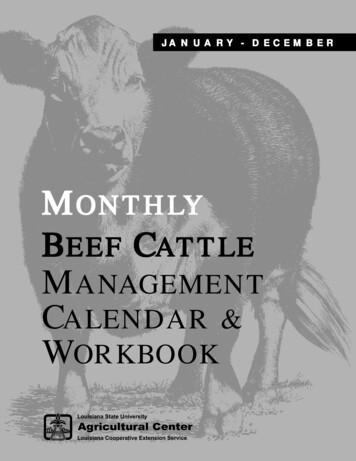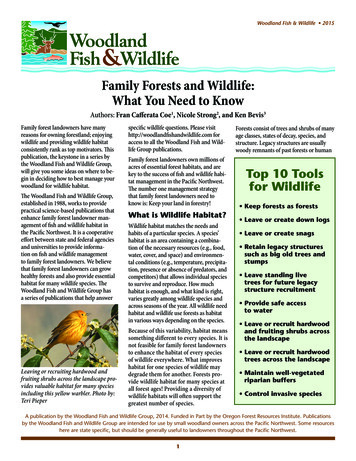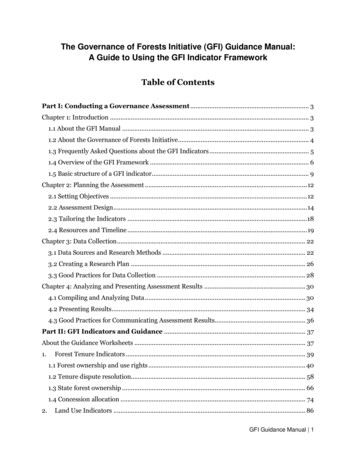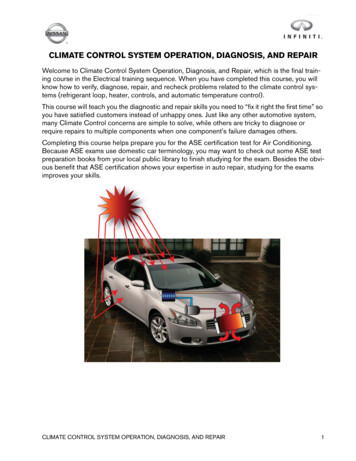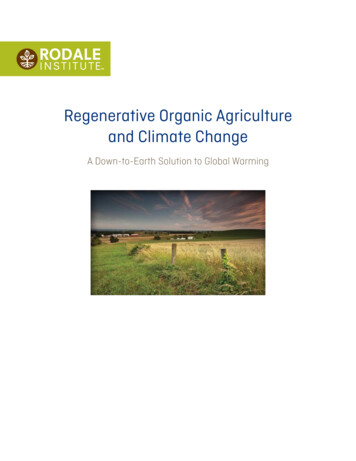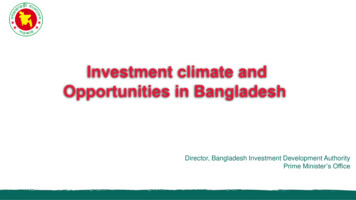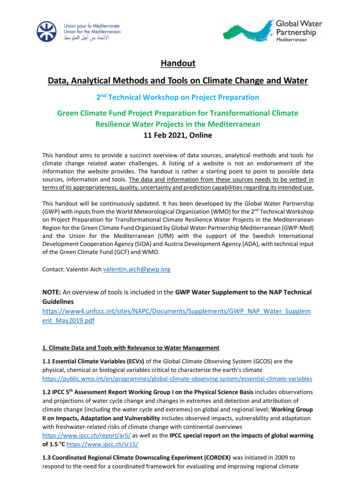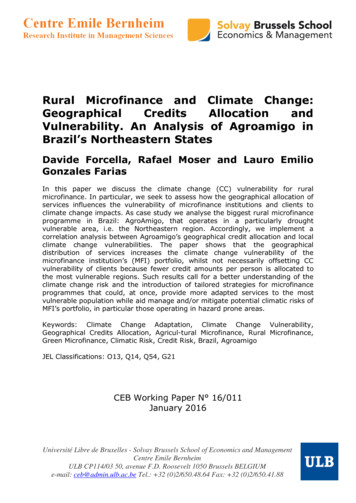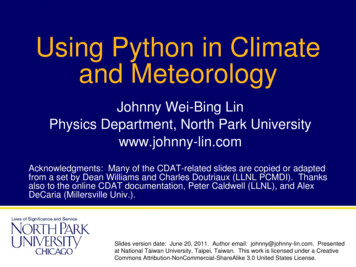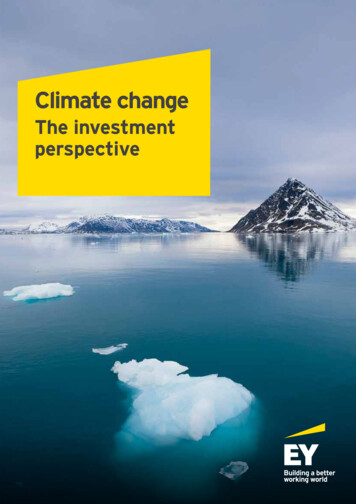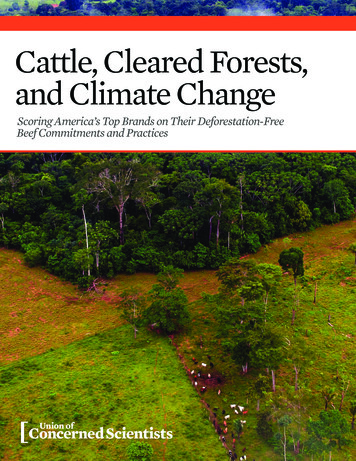
Transcription
Cattle, Cleared Forests,and Climate ChangeScoring America’s Top Brands on Their Deforestation-FreeBeef Commitments and PracticesDon AnairAmine MahmassaniJuly 2013
Each year, tropical forests are destroyed to clear landthat is ultimately used for beef production, makingbeef the largest driver of tropical deforestationglobally. South America’s forests are “ground zero”for beef-driven deforestation.Here, ranchers clear tropical forests and other ecosystemssuch as native grasslands and woodlands to create pastures,in the process releasing enormous amounts of heat-trappinggases, destroying the habitat of wildlife such as jaguars andsloths, and encroaching on the homes of vulnerable indigenous peoples.The Union of Concerned Scientists (UCS) evaluated13 consumer goods companies in the fast food, retail, andfood manufacturing sectors that have the power to help stopthis destruction. They each source beef from South Americaand should work with their South American suppliers to helpchange practices in order to ensure that the beef in theirproducts is not causing deforestation. UCS has found thateven companies taking action on this issue have major gapsin their policies and practices that mean they may be profitingfrom selling “deforestation-risk beef,” or beef produced without safeguards that would prevent deforestation.Nine of the 13 companies we scored lack any publicpolicies or plans detailing how they intend to completelyeliminate deforestation associated with their beef purchases.Of these nine, four did not receive a single point on our scorecard: Burger King, ConAgra, Kroger, and Pizza Hut. Subwayearned only five points. Four others—Hormel, Jack Link’s,Safeway, and Wendy’s—source their beef from suppliersimplementing some practices to prevent deforestation inSouth America, but these companies should work with theirsuppliers to address the limitations of these practices and alsopublicly demonstrate that they have strong deforestation-freepolicies and action plans of their own in place. Nestlé has adeforestation-free beef commitment but needs to make moreprogress implementing it.The companies making the most progress in adoptingand implementing deforestation-free beef commitmentsand practices are Mars, McDonald’s, and Walmart, but theyalso have much room for improvement. First, not all of theirsupplying ranches are traced and monitored for deforestation,which means every company we scored cannot guarantee2union of concerned scientiststhat its beef is truly deforestation-free. Second, each of thesecompanies with a commitment focuses implementation onlyon the Brazilian Amazon, even though many other ecosystems are also at risk. All companies also lack adequate transparency, which leaves consumers and investors in the darkabout whether companies are carefully monitoring andevaluating their supply chains for tropical deforestation.Beef can be produced without deforestation. The companies scored in this report have the power to help save forestsand our climate. Thanks to consumer demand, governmentaction, and nongovernmental organization (NGO) advocacy,some companies and their suppliers have taken steps to address this risk, but all the companies scored lack sufficientpolicies and practices to ensure the beef in their products isnot connected to tropical deforestation in South America.Consumers can help save forests by demanding that these13 companies take deforestation off their menus and out oftheir ingredients by working with their suppliers to implement verified deforestation-free practices. When consumersspeak, companies listen and act.Why Beef?Beef production is the number-one driver of tropical deforestation in South America and worldwide (De Sy et al. 2015;Henders, Persson, and Kastner 2015). Analysis of nations withhigh rates of tropical deforestation has shown that the amountof deforestation fueled by beef production is more than twiceas large as the combined amount resulting from the productionof soy, palm oil, and wood products—the next three largestdrivers of tropical deforestation (Henders, Persson, and Kastner 2015). In South America, beef production was responsiblefor 71 percent of total deforestation between 1990 and 2005(De Sy et al. 2015). Cattle are raised primarily for meat anddairy products, but the industry also produces a number ofother cattle products, such as fats, leather, and gelatin, whichcan be found in everything from lotion to shoes.Cover photo: CIFOR/Creative Commons (Flickr)
Rhett Butler/mongabay.comForests are also cleared to produce soybeans, which are used as animal feed in poultry, pork, and beef operations.Soy, the second largest driver of deforestation, also heavily affects the South American landscape. Every year, aroundhalf a million hectares are deforested for soy in major soyproducing tropical nations (Henders, Persson, and Kastner2015). The majority of soy is used as animal feed; around70 to 75 percent of the world’s soy ends up as feed for cows,chickens, pigs, and farmed fish (Brack, Glover, and Wellesley2016). Thus, soy is also connected to South America’s largestmeatpackers, which use large amounts of animal feed in theirbeef, poultry, and pork operations. While some progress hasbeen made in tackling deforestation resulting from productionForest destructionleads to the release ofmassive amounts ofheat-trapping gases andthe subsequent effectson climate, along withreduced biodiversity.of these two commodities, forests are still disappearing tomake room for soy and pastureland expansion.Forest destruction leads to the release of massiveamounts of heat-trapping gases and the subsequent effects onclimate, along with reduced biodiversity. When forests are cutdown or set on fire to make way for agriculture, the vegetation decomposes or burns, releasing carbon into the atmosphere. In total, around 10 percent of annual global carbondioxide emissions result from tropical deforestation (UCS2013). Forest destruction also leads to habitat loss for a variety of species. Tropical forests contain some two-thirds ofthe planet’s land species (Gardner et al. 2009), and forestsin South America provide habitat for species such as jaguars,harpy eagles, and sloths. In addition, tropical forests helpclean the air and water and regulate local temperatures andprecipitation. If deforestation continues at current rates,regional climate changes such as reduced precipitation couldlower pasture productivity in the Brazilian Amazon up to33 percent by 2050 (Oliveira et al. 2013). Thus, deforestationcan be a lose-lose situation for all of us who rely on a stableclimate and for the ranchers whose livelihoods depend onsufficiently productive land.Around one billion people worldwide rely on forests tosome extent for their livelihoods. Deforestation for pastureland expansion can therefore harm local communities andindigenous peoples by depriving them of this resource (ChaoCattle, Cleared Forests, and Climate Change3
Rhett Butler/mongabay.com2012). Insecure land rights have also led to land grabbing,deforestation, and conflict over land ownership (Chao 2012;Puppim de Oliveira 2008). Protecting the rights of localcommunities and indigenous peoples can have positiveoutcomes for forests. The rate of deforestation is 7 to 11 timeslower in the Brazilian Amazon in protected areas and onlands where indigenous peoples hold effective land ownership than in other regions (Ricketts et al. 2010). These areascreate a crucial barrier, backed by force of law, which canhelp alleviate agriculture-driven deforestation occurring insurrounding areas.This report discusses the problem of beef as a driver oftropical deforestation and recommends solutions. Beef canbe produced in several different ways, each with its own implications for animal welfare, public health, workers, localcommunities, and the environment. There are a number ofreasons consumers might consider reducing their consumption of beef. Studies have shown that overconsumption ofbeef leads to an increased chance of developing cardiovascular disease, certain cancers, and other health conditions(Sinha et al. 2009). Beef production also involves muchgreater land and water use and global warming emissionscompared with other protein sources (Ranganathan et al.2016). Livestock production emits roughly 14.5 percent of allglobal warming emissions, with cattle responsible for themajority of this pollution (Gerber et al. 2013). Beef productioncauses global warming through its effects on deforestation,both directly through pasture expansion and indirectlythrough its use of feed, which can be produced in ways thatdrive deforestation and climate change. Cattle also releasemethane, a powerful heat-trapping gas, through the functionof their digestive systems. This report focuses exclusively onthe impacts of the South American beef industry as it relatesto tropical deforestation, the consequent global warming emissions, and what multinational consumer goods companies cando to address this issue.While expansion of pastureland has also driven deforestation in regions outside South America, this report focuseson South America because of its sizable forest loss due topastureland expansion and because of South American beef’sconnection to the global marketplace (Henders, Persson, andKastner 2015). Additionally, although many other cattleproducts, such as tallow, leather, gelatin, and glycerol, may belinked to deforestation risk in South America, these productsare not a focus of our report.* However, we did award pointsto companies if they had a commitment to ensure their beefand all other cattle products do not fuel deforestation.Tropical forests contain some two-thirds of the planet’s land species. Destructionof forests for expansion of cattle pasture leads to habitat loss for a variety ofspecies, such as jaguars.Deforestation-Risk Beef and the US MarketThe United States has historically had bans on fresh andfrozen beef from Argentina and Brazil—the beef-exportingpowerhouses of South America—because of foot-and-mouthdisease concerns. However, the United States Department ofAgriculture has begun the process of lifting these bans. Consumption by Americans of deforestation-risk beef in the formof hamburgers, steaks, and the like is therefore becoming increasingly likely. Yet deforestation-risk beef has already madeits way into the US market in the form of processed beef, suchas beef jerky sold by Jack Link’s and canned corned beef soldby Kroger and Safeway. In 2015, the United States was the topdestination for processed beef exports from Brazil (ABIEC2016). The United States is also one of the largest importersof leather goods, and it imports many of these products fromcountries that receive hides from South America (UnitedNations Comtrade Database 2015). Therefore, leather products such as jackets, car upholstery, and boots sold in theUnited States may also be connected to deforestation inSouth America.* In this report, we define beef to include fresh and frozen beef (typically consumed as steaks and hamburgers, for instance), beef jerky, offal (often found in petfood), and canned corned beef. Cattle products include beef and such by-products and co-products as tallow, leather, gelatin, and glycerol.4union of concerned scientists
However, with some exceptions (such as Paraguay), beefis most often consumed in the country of production; thus,most South American deforestation-risk beef is consumedwithin South America (FAO Statistics Division 2010). Butmany US-based companies, including global fast foodrestaurants such as Burger King and Pizza Hut, operate inSouth America and sell beef produced there to their SouthAmerican customers.Understanding the Beef Supply ChainThe beef supply chain in South America is complex. Cattleeventually end up at a direct supplying ranch—a ranch thatsells directly to the meatpacker (slaughterhouse). A fewmeatpackers monitor their supply chain, though they monitoronly the direct supplying ranches for deforestation. But before cattle reach the direct supplying ranch, ranchers oftenmove them to different ranches for different stages of production. The three stages of production are: breeding, raising,and fattening. Cattle are also frequently relocated to differentranches via intervening actors and transactions such as traders and auctions. Any of these indirect supplying ranches(ranches through which cattle travel before arriving at thedirect supplying ranch) may be associated with deforestation.But, because the meatpacker monitors only the direct supplying ranch, it does not actually know whether the cattle it buysare associated with deforestation on an indirect supplyingranch. Meatpackers process the cattle into fresh beef, frozenbeef, processed beef, and other products. Given the hugevolume of beef they process, their relationships with cattleranchers, and the control they exert over market access,meatpackers can play a pivotal role in stemming deforestationresulting from beef production.After processing, meatpackers sell the cattle productsdirectly to consumer goods companies or to a secondary processor that then sells the finished goods to consumer goodscompanies. Consumer goods companies, such as ConAgra,Jack Link’s, Kroger, Mars, Nestlé, and Safeway, then sell thesefinished cattle products to US consumers; these products endup on our plates or in our cosmetics, handbags, or pet food.The South American operations of US companies—includingfast food restaurants such as Burger King, McDonald’s, PizzaHut, Subway, and Wendy’s and retailers such as Walmart—also receive beef from these meatpackers, which is then soldto South American consumers in the form of burgers, pizzatoppings, and sandwich meat, for example.Currently, all 13 of the scored companies in this reportlack sufficient policies and practices to ensure they are notpurchasing beef sourced from ranches associated with recentdeforestation. These companies have a responsibility to workHow Deforestation Can Hide in the BeefSupply ChainFIGURE 1.Indirect Supplying RanchDirect Supplying RanchMeatpackersCORNEDBEEFConsumer Goods CompaniesThis is one example of how deforestation-risk beef enters the supplychain—through a meatpacker’s indirect supplying ranches. Indirectsupplying ranches are often not monitored for deforestation. However, many meatpackers do not monitor their direct supplying ranchesfor deforestation either.Cattle, Cleared Forests, and Climate Change5
Thinkstock.com/Polka Dot collectionThe best way for US consumers to reduce tropical deforestation is to demand thatmultinational consumer goods companies such as those profiled in this reportpurchase beef only from meatpackers that buy and process deforestation-freecattle exclusively.with their South American supplying meatpackers, whichhave enormous influence over the beef supply chain, to adoptrobust deforestation-free policies and practices. And we, asconsumers, have a critical role to play by demanding they doso and showing we are unwilling to support companies buying deforestation-risk beef. Calls from consumers and investors for companies to buy only zero-deforestation palm oilestablished responsible palm oil policies as the industrynorm. While more work is needed to convert such policiesinto responsible production practices at palm oil plantationsacross the globe, there is huge potential to replicate thissuccess by using the same approach to reduce tropicaldeforestation driven by cattle ranching in South America.Beef Can Be Produced without DeforestationSome progress in reducing rates of tropical deforestation hasbeen made in recent years, with the majority of the reductionoccurring in the Brazilian Amazon thanks to collaborationbetween the public and private sector. Between 2005 and2014, deforestation rates in the Brazilian Amazon dropped byabout 70 percent (Lapola et al. 2014). Because pasture expansion has been responsible for the vast majority of Amazondeforestation in recent years, the drop in overall deforestationis an indication that deforestation associated with beefdropped as well (Boucher et al. 2014). A variety of factors isresponsible. During this period, strong social and environmental movements erupted and Brazil’s political leadership6union of concerned scientistsprioritized the conservation of the Amazon forest (Boucheret al. 2014); this led to zero-deforestation private sectoragreements and several government measures passing. Thesezero-deforestation private sector agreements and policieshave proven critical in addressing deforestation in the BrazilianAmazon given the Brazilian government’s recent weakeningof some forest protection laws and gaps in its policies thatallow some deforestation (Soares-Filho et al. 2014).Responding to NGO pressure—such as Greenpeace’s2009 report Slaughtering the Amazon, which shed light oncorporations linked to forest destruction—and internationalpressure, the four largest meatpackers in Brazil signed theMinimum Criteria for Industrial Scale Cattle Operations inthe Brazilian Amazon Biome agreement. Better known as theG4 Agreement or the Cattle Agreement, it required the signing meatpackers—Bertin, JBS, Marfrig, and Minerva—toascertain in ways that can be monitored, verified, andreported that their supplying ranches are not linked todeforestation. However, the Cattle Agreement’s influenceis limited. It currently applies only to the three largest meatpackers (Bertin was later bought by JBS) and protects onlythe Brazilian Amazon. And meatpackers have so far stalledin implementing the requirement that all cattle ranches inthe meatpackers’ supply chains be monitored, includingindirect supplying ranches. Consumer goods companiestherefore must work with their supplying meatpackers tomake more progress in addressing risk at all ranches in theirsupply chains, including those outside the Brazilian Amazon. Nevertheless, the agreement has been a historic steptoward corporate actors taking responsibility for their rolein driving deforestation.In places where the Cattle Agreement has been coupledwith strong government policies, evidence of changes in practices has emerged. For instance, meatpackers operating in theBrazilian state of Pará, after being sued by the federal publicCurrently, all 13 of thescored companies in thisreport lack sufficientpolicies and practicesto ensure they are notpurchasing beef sourcedfrom ranches associatedwith recent deforestation.
Deforestation (square kilometers)FIGURE 2.Deforestation in the Brazilian Amazon30,00025,00020,000Soy Moratorium Signed15,000Cattle Agreement 101112131415YearIn addition to government policies and regulations, two voluntary agreements have contributed to the reduction of deforestation in the Brazilian Amazon: the SoyMoratorium, signed by some of the largest soybean traders, and the Cattle Agreement, signed by some of the largest meatpackers in the cattle industry. By signingthem, major soybean traders and meatpackers pledged to ensure their production of soy and beef respectively do not fuel deforestation in the Brazilian Amazon.SOURCE: MONGABAY 2016.prosecutor’s office, signed Terms of Adjustment of Conduct(MPF-TAC) agreements, which legally pushed meatpackersand ranches to begin addressing deforestation in their supplychains and on their properties, respectively. After signingthe MPF-TAC and Cattle Agreement, the meatpacker JBSchanged its purchasing behavior to buy only from direct supplying ranches not associated with deforestation. Moreover,JBS’s direct supplying ranches registered their propertieswith the government faster than did other ranches, and therate of deforestation associated with these ranches droppedmore significantly than did the rates associated with otherranches (Gibbs et al. 2016). In this case, government policiesand pressure from NGOs played a crucial role in meatpackersand ranchers taking steps to reduce deforestation.Progress in reducing soy-driven defore
Cover photo: CIFOR/Creative Commons (Flickr) Each year, tropical forests are destroyed to clear land that is ultimately used for beef production, making . . direct supplying ranch) may be associated with deforestation. union of concerned scientists
